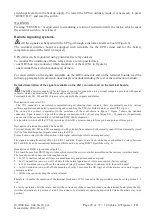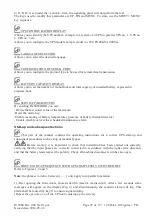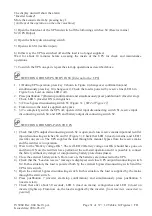
IV306E Rev. 004 Siel S.p.A.
Page 20 of 37 + 12 Tables, 14 F FR
Issued date: 2014-03-24
switch upstream from the backup supply. To restart the UPS in ordinary mode, it is necessary to press
“RESET R.E.” and reset the switch.
WARNING
Pressing “TEST R.E.” is equivalent to simulating a return of current towards the mains, which causes
the external switch to be released.
Remote signalling systems.
All the signals exchanged with the UPS go through a customer interface board (Figure 6).
The customer interface board is equipped with terminals for the EPO circuit and for the battery
temperature sensor (the latter on request).
UPS status can be monitored using potential-free relay contacts.
To monitor the conditions of these relays, there are two possibilities:
- one DB9 box-type connector which monitors 4 of them (CN1 in Figure 6)
- one terminal block which monitors all of them.
For more details on the signals available on the DB9 connector and on the terminal boards, read the
following paragraph (its omission does not prevent understanding the rest of the instruction manual).
Detailed description of the signals available on the CN1 connector and on the terminal boards.
The DB9 drawer connector (CN1 in Figure 6) is used for connection to a personal computer, provided with special
software, which can monitor the UPS status and control switch-off.
Terminal blocks M1, M2 and M3 (Figure 6) also supply further signals and alarms.
Description of connector CN1
- The CN1 connector is an isolated communication port showing clean contacts; these are normally used by various
software applications dedicated to monitoring and controlling the UPS (for further details, contact SIEL S.p.A.).
The closing of a contact is equivalent to the occurrence of the event shown in figure 7. Figure 7 shows the standard
connection. Upon request, it is possible to change connections to the various pins through J1 ... J6 jumpers. (In particular,
you can order the connection kits to AS 400 and RISC 6000 computers.)
It is possible to switch off the UPS by injecting a 10mA DC current coming in from pin 4 and going out from pin 6.
Description of terminal boards M1, M2 and M3.
Terminal blocks M1, M2 and M3 are equipped with potential-free contacts (both normally open (NO) and normally closed
(NC)) of the most important signals concerning the UPS.
Figure 8 shows relays in the idle position, while signal indications refer to an energised relay.
The signals coming from relays RL1, RL2, RL3 and RL4 (Figure 6) are fixed, while the ones handled by relays between
RL5 and RL10 can be customised; implement this function by using DSW1 dipswitches (Fig. 6)
Description of DSW1 dipswitches (Figure 8).
This board houses four DSW1 dip-switches which control the microcontroller assembled on the customer interface board.
The four dip-switches have the following functions:
1. – In 1111 condition (all on) all relays are simultaneously and permanently energised.
2. – In 1110 condition (on, on, on, off) all data for the normal operation of relays are acquired (factory setting).
3. - in 1101 condition (on-on-off-on) the meaning of relay 9 becomes “Mains switchover
Inverter blocked”
4. - in 1100 condition (on-on-off-off) the meaning of relay 9 becomes the OR logic of all the alarms (to remote trigger a
cumulative alarm)
5. - All the other positions keep the relays released.
Therefore, to enable the operation of the terminal block and of CN1 connector, the dip-switches must be set to position 2. 3
or 4.
To verify operation of all the relays, and test the correctness of the connections made on the terminal board, place the dip-
switches alternatively in positions 1 and 5 (for instance by alternatively operating dip-switch 1 while the others stay in on
position).






























